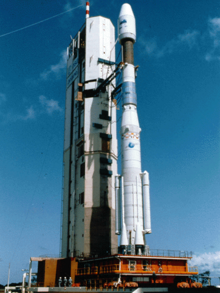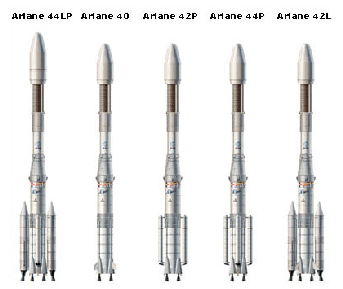Ariane 4
This rocket article contains payload capacity, but does not include orbital altitude or inclination, which greatly affects the capacity. |
 The 52nd Ariane 4 carrying TOPEX/Poseidon | |
| Function | Expendable launch vehicle |
|---|---|
| Manufacturer | Arianespace |
| Country of origin | Europe |
| Size | |
| Height | 58.72 m (192.7 ft) |
| Diameter | 3.8 m (12.5 ft) |
| Mass | 240,000 - 470,000 kg (529,110 - 1,036,175 lb) |
| Stages | 2 |
| Capacity | |
| Payload to LEO | |
| Mass | 5,000 - 7,600 kg(11,024 - 16,756 lb) |
|
, | |
| Payload to GTO | |
| Mass | 2,000 - 4,300 kg(4,410 - 9480 lb) |
| Launch history | |
| Status | Retired |
| Launch sites | Kourou ELA-2 |
| Total launches | 116 (40: 7, 42P: 15, 42L: 13) (44P: 15, 44LP: 26, 44L: 40) |
| Success(es) | 113 (40: 7, 42P: 14, 42L: 13) (44P: 15, 44LP: 25, 44L: 39) |
| Failure(s) | 3 (42P: 1, 44L: 1, 44LP: 1) |
| First flight | 40: 22 January 1990 42P: 20 November 1990 42L: 12 May 1993 44P: 4 April 1991 44LP: 15 June 1988 44L: 5 June 1989 |
| Last flight | 40: 3 December 1999 42P: 4 May 2002 42L: 23 January 2002 44P: 25 September 2001 44LP: 27 November 2001 44L: 15 February 2003 |
| Boosters (Ariane 42L, 44LP or 44L) – PAL | |
| No. boosters | 0, 2 or 4 |
| Powered by | Viking 6 |
| Maximum thrust | 752.003 kN (169,057 lbf) |
| Specific impulse | 278 sec |
| Burn time | 142 seconds |
| Propellant | N2O4/UDMH |
|
, | |
| Boosters (Ariane 42P, 44LP or 44P) – PAP | |
| No. boosters | 0, 2 or 4 |
| Maximum thrust | 650 kN |
| Burn time | 33 sec |
| Propellant | CTPB 1613 |
|
, | |
| First stage – L220 | |
| Powered by | 4 Viking 5C |
| Maximum thrust | 3,034.1 kN |
| Specific impulse | 278 sec |
| Burn time | 205 sec |
| Propellant | N2O4/UDMH |
|
, | |
| Second stage – L33 | |
| Powered by | 1 Viking 4B |
| Maximum thrust | 720.965 kN |
| Specific impulse | 296 sec |
| Burn time | 132 seconds |
| Propellant | N2O4/UDMH |
|
, | |
| Third stage – H10 | |
| Powered by | 1 HM7-B |
| Maximum thrust | 62.703 kN |
| Specific impulse | 446 sec |
| Burn time | 759 seconds |
| Propellant | Lox/LH2 |
Ariane 4 was an expendable launch system, designed by the Centre national d'études spatiales and manufactured and marketed by its subsidiary Arianespace. Ariane 4 was justly known as the "workhorse" of the Ariane family. Since its first flight on 15 June 1988 until the last, on 15 February 2003, it made 113 successful launches. It was known to be an extremely versatile launcher.[not verified in body]
The Ariane 4 proved ideal for launching communications and Earth observation satellites as well as those for scientific research. During its working life, Ariane 4 captured 50% of the market in launching commercial satellites, demonstrating Europe's ability to compete in the commercial launch sector.[1]
History
In 1973 eleven countries, called together by the European Space Agency (ESA), decided to take Europe down its own path in the space field. Six years later in 1979, Ariane 1 was launched from Kourou. Following development work on variants 1, 2 and 3, Ariane 4 was able to draw on the experience gained from these earlier variants.
The development program began in 1983 and the first successful launch was on 15 June 1988. The system became the basis for a European satellite launches with a record of 113 successful and three launch failures. Ariane 4 provided a payload increase from 1700 kg for Ariane 3 to a maximum of 4800 kg to geostationary transfer orbit (GTO). The record for Ariane 4 to GTO was 4946 kg.[2]
The Ariane 4 Launch Team was awarded the Space Achievement Award by the Space Foundation in 2004.[3]
Vehicle Description
The Ariane 4 was the ultimate development from the Ariane 1,2,3. Compared with the Ariane 2/3, the Ariane 4 featured stretched first (61%) and third stages, a strengthened structure, new propulsion bay layouts, new avionics, and the SPELDA (Structure Porteuse Externe de Lancement Double Ariane) dual-payload carrier. The basic 40 version used no strap-on motors, while the Ariane 42L, 44L, 42P, 44P, and 44LP versions used various combinations of solid and liquid boosters. Development was authorised in January 1982, with the objective of increasing payload by 90%. Total development cost 476 million 1986 ECU's.[4]
Originally designed to place 2-4.2 tonne payloads in geostationary orbit, the six Ariane 4 variants, aided by strap-on boosters, enabled the launch of payloads in excess of 4.9 tonnes on several occasions.[citation needed]
Variants
The rocket was used in a number of variants - it could be fitted with two or four additional solid (PAP - Propulseurs d'appoint à poudre) or liquid fueled booster rockets (PAL - Propulseurs d'appoint à liquide). The launcher included a satellite payload carrier system called Spelda (Structure porteuse externe de lancement double Ariane, French for 'External carrying structure for Ariane double launches') for launching more than one satellite at a time. The rocket captured nearly 60% of the world’s commercial launch services market, serving both European and international clients.[5]
Ariane 4 AR 40 was the basic version, with three stages: 58.4 m high, a diameter of 3.8 m, a liftoff mass of 245 t and a maximum payload of 2100 kg to GTO or 5000 kg to Low Earth orbit (LEO). Main power was from four Viking 2B motors each producing 667 kN of thrust. The second stage had a single Viking 4B motor, and the third stage had an HM7-B liquid oxygen/liquid hydrogen motor. AR 44L, with the maximum additional boost of four liquid fuel rocket strap-ons, was four-stage, weighed 470 t and could transfer a payload of 4730 kg to GTO or 7600 kg to LEO.

| Model | PAL | PAP | Payload to GTO, kg | Launches | Successes | Failure date |
|---|---|---|---|---|---|---|
| AR 40 | ||||||
| AR 42P | 1 December 1994 | |||||
| AR 42L | ||||||
| AR 44L | 22 February 1990 | |||||
| AR 44LP | 24 January 1994 | |||||
| AR 44P |
Launches
The inaugural flight of Ariane 4 took place in 1988. Since then has accomplished 116 flights with a success rate of more than 97%. The final launch of Ariane 4 rocket occurred on 15 February 2003, placing Intelsat 907 into geosynchronous orbit.[6]
Retirement
In 2003, Arianespace phased out Ariane 4 in favour of the heavy-lift Ariane 5. In 2011, the medium-lift Soyuz ST complemented the offering of launch vehicles from the Guiana Space Centre. Spacecraft launched by the Soyuz reuse the payload platform and dispenser originally designed for the Ariane.[7]
Comparable Rockets
See also
- Comparison of orbital launchers families
- Tsyklon-4 (Ukrainian carrier rocket with fairing derived from Ariane 4)
References
- ^ "Ariane 4 / Launchers / Our Activities / ESA". ESA. 14 May 2004. Retrieved 13 June 2015.
- ^ "Ariane 4". Airbus Defence and Space. Retrieved 13 June 2015.
- ^ "Space Achievement Award". Space Symposium. Retrieved 13 June 2015.
- ^ "Encyclopedia Astronautica - Ariane". Encyclopedia Astronautica. Retrieved 13 June 2015.
- ^ "Ariane 4, un défi pour l'Europe spatiale" [Ariane 4 - A challenge for Europe's space industry] (in French). CNES. Retrieved 13 June 2015.
- ^ "Intelsat 907 Launched on Final Ariane 4 Mission". SpaceRef. 15 February 2003. Retrieved 13 June 2015.
- ^ "Soyuz User's Manual" (PDF). Arianespace. March 2012. Retrieved 13 June 2015.
External links

